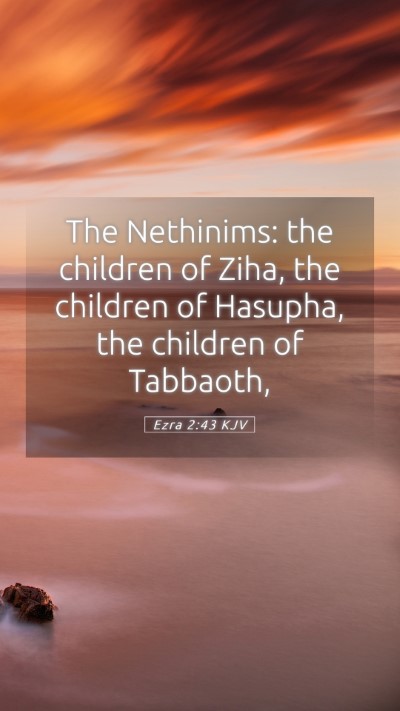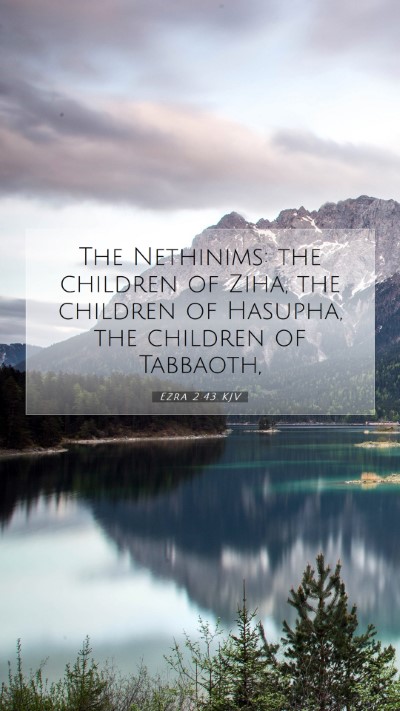Bible Verse Commentary: Ezra 2:43
Verse: Ezra 2:43 - "The Nethinim: the children of Ziha, the children of Hashupa, the children of Tabbaoth."
Understanding Scripture: This verse is a part of the genealogical list that details the groups that returned to Jerusalem from Babylonian exile. The Nethinim, or temple servants, play a crucial role in the rebuilding efforts, dedicated to assisting the priests and Levites in their sacred duties. The mention of specific families highlights the importance of lineage and identity within the restored community.
Meaning of Bible Verses
Ezra 2:43 offers insights into the organization and social structure of the returning exiles. The Nethinim had been set apart for service in the temple, indicating their unique role in the religious life of Israel. Each name can be viewed as a representation of faithfulness to God’s covenant.
Bible Verse Interpretations
Commentaries shed light on the cultural and historical implications of this verse:
- Matthew Henry: Explains that the Nethinim were originally Gibeonites who were designated for temple service, demonstrating God’s ability to use all people in His divine plan.
- Albert Barnes: Suggests that the meticulous listing emphasizes the fulfillment of God’s promises, and the returning exiles were reclaiming their rightful place as inhabitants of the holy city.
- Adam Clarke: Notes the importance of the role these individuals played in maintaining temple worship, mercy, and service to the community, reflecting the communal effort to restore God’s house in Jerusalem.
Bible Study Insights
The verse serves as a reminder of the diverse contributions to temple activities, reinforcing the concept that service to God is multifaceted, with each person playing a part in the larger narrative of restoration. Understanding such details is essential for grasping the entirety of the biblical message.
Historical Context of Bible Verses
The return from exile was a pivotal moment in Jewish history, and Ezra’s narrative focuses significantly on the restoration of worship and the return to covenant faithfulness. The Nethinim symbolize those who may not have had the same heritage as the priests and Levites, yet were integral to the spiritual renewal of the community.
Application of Bible Verses to Daily Life
For modern readers, Ezra 2:43 challenges individuals to consider their roles in community life. Just as the Nethinim served, contemporary believers are called to find their purpose and contribute to the church and society at large. It illustrates that every role, no matter how small, contributes to the greater goal of honoring God.
Additional Insights from Public Domain Commentaries
Scholars and theologians emphasize that the rebuilding efforts in Jerusalem extended beyond physical structures; it was about re-establishing a national and spiritual identity that had been lost during the exile. This verse encapsulates part of that journey, as they sought to be a people once again devoted to the Lord.
Cross References
- 1 Chronicles 9:2: Lists the Nethinim and their roles within the temple.
- Nehemiah 11:3-5: Discusses the divisions among the inhabitants of Jerusalem, including the Nethinim.
- Joshua 9:27: States the origin of the Gibeonites who became the Nethinim.
Conclusion
Ezra 2:43, while seemingly just a list of names, illustrates broader themes of identity, service, and community restoration. Understanding such scripture allows for deeper engagement with God’s Word. For those involved in Bible study groups or online Bible study, this verse serves as a powerful reminder of the importance of each member’s contribution in fulfilling God’s purposes.
In summary, the significance of Ezra 2:43 underscores the importance of every believer's role in God’s plan. Whether through direct service or support of others, understanding biblical passages such as this fosters a deeper appreciation of the individual and collective journeys of faith.


